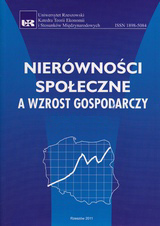Rola instytucji edukacyjnych w zapewnianiu włączenia społecznego: analiza przypadku Szwecji
The role of educational institutions in assuring social inclusion
Author(s): Piotr WetoszkaSubject(s): Education, Socio-Economic Research
Published by: Wydawnictwo Uniwersytetu Rzeszowskiego
Keywords: Sweden; educational politics; migration politics; social inclusion
Summary/Abstract: The aim of this paper is to examine educational institutions and recent education policy reformsin Sweden within the context of immigration. The education is known to have impact onenhancing the quality of human capital and social inclusion. However, as it is suggested in the literatureon educational segregation, any means of inclusion are exclusive at the same time. Does thisremain true in the case of Sweden?To answer this question, the analytical framework by B. Stauber and M. P. do Amoral (accompaniedby S. J. Peters’ criteria of cost effectiveness) has been adopted, including three axesof analysis: effectiveness, adaptability, and universalism (ability to ensure unrestrained access toeducation). The methodology involves a reflective study of recent works about social inclusion andimmigration, including reports from OECD, UE and the Swedish National Agency for Education.The variety of institutions offering free access to differentiated courses in Sweden does reflecta potential of social inclusion. Yet, educational outcomes of foreign-born citizens are not satisfactoryin comparison with those achieved by Swedes and in relation to rising costs of financing primary,secondary and upper-secondary education.The reforms introducing decentralisation and free school choice do create new possibilities butalso lead to more segregation across regions and schools or leave known problems unsolved. Thethesis of inclusive education being exclusive at the same time can be therefore born out but onlywhen accepting the limitations of the undertaken study and the need for deepened analysis using thegiven framework.
Journal: Nierówności Społeczne a Wzrost Gospodarczy
- Issue Year: 2017
- Issue No: 51
- Page Range: 219-230
- Page Count: 12
- Language: Polish

